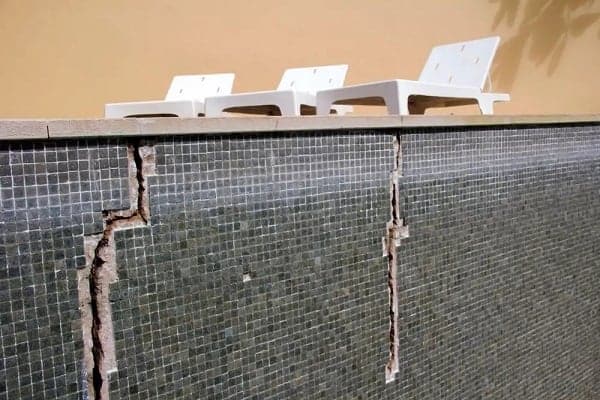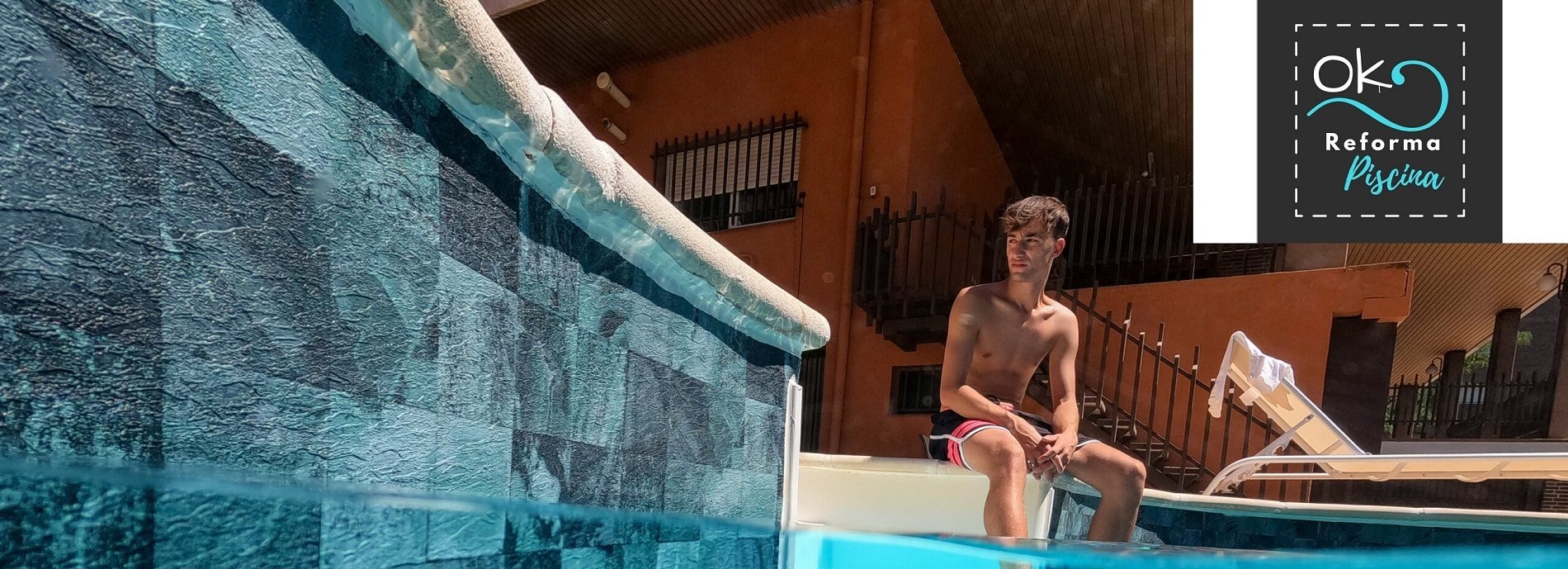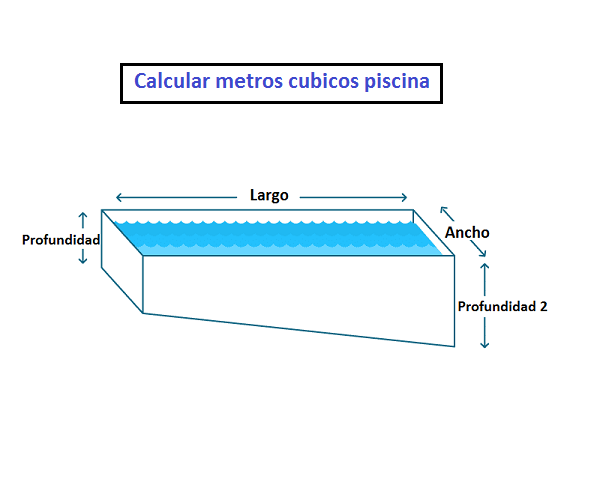
Table of contents of the page
En Ok Pool Reform and within the category of Main Causes of Water Leaks in Swimming Pools and How to Detect Them we leave you with this page Structural pool fissure: water leaks in the pool shell
First of all: Check if there is water loss from the pool

Examining the water lost by the pool will tell us if there really is a leak or not.
Inspect if the water loss from the glass is within the normal range.
Pool water loss level within normal range
- Although, as a fairly general rule, a pool can lose its 2 to 3,75cm of water per week due to climatological causes (evaporation), of use or of the filtering system itself.
Check that the pool is not too full
- First, check your water level and make sure it is not too full by more than an inch from normal levels.
- If it is overfilling, adjust the fill valve accordingly.
- Finally, closely monitor the water levels in your pool to catch any problems early on, and contact a professional if you suspect a problem with your pool wall.
From regularly maintaining the water level and sealing any gaps to monitoring your pool wall for signs of damage, there are a number of steps you can take to prevent and address leaks behind your pool liner.
What are water leaks in structural pools?

What are cracks or fissures that cause pool leaks?
In short, cracks are long, narrow openings or breaks that appear in the material in which the pool shell is constructed.
Why do cracks form in swimming pools?

There are a number of factors that can contribute to the formation of cracks in swimming pools.
Circumstances that help cause cracks in concrete pools
- These can include the effects of time and motion, such as expansion and contraction due to changes in water pressure or the movement of earth beneath the pool's surface.
- Additionally, exposure to sunlight and temperature fluctuations can also cause cracking, especially if the pool is made of materials that are sensitive to these environmental conditions.
Whatever the cause, it is important to take action quickly to prevent further damage and ensure your pool remains safe and functional for years to come.

What causes cracks in concrete pools?
One of the most common problems that can arise with swimming pools is a leak. This type of leak can be caused by structural problems, such as cracks or fissures in the pool walls or liner.
It is important to address these leaks as soon as they are detected, so that they do not cause further damage to your pool and its surroundings. There are a number of methods you can use to detect and repair leaks in your pool, including visual inspection, water testing, and professional assistance.
If you suspect that your pool might have a leak, it is important that you first fully inspect the entire structure for signs of wear or damage.
This may include looking at the siding or wall materials for cracks or other defects, checking the plumbing system for leaks or clogs, and examining areas around the pool where water may be escaping.
Once you have identified any possible leaks in your pool, you can begin testing the water to determine where exactly the leak is coming from. One way to do this is to perform a bucket test. This involves filling an empty bucket with pool water until it overflows, and then measuring the amount of water that passed into the surrounding soil. If there is more than 1 inch of overflow outside your pool, it may be indicative of a leak somewhere along the wall or liner.
If you cannot identify a leak on your own, or if it appears to be too large or complex to repair, it may be necessary to seek the help of a professional pool repair technician.
These professionals will be able to fully evaluate your pool structure, identify leaks and damage, and recommend the best course of action to repair them. Depending on the severity of the leak, this may involve applying sealant or other waterproofing material to damaged areas, repairing small holes, or completely replacing sections of the pool wall. With proper care and maintenance, you can ensure that your pool remains in good condition for years to come.
How to repair a crack in a concrete pool?
Once the patch has been applied and dried, it is time to fill the pool with water. This should be done slowly to prevent further damage or leaks from occurring. When filling your pool, be sure to never fill it above its maximum capacity, as this can cause further leaks or structural damage. If necessary, use a pump to slowly refill the pool over a long period of time until it reaches the desired level
After filling the pool with water, inspect carefully for any signs of leaks that may have been caused by air bubbles trapped in the patch area. If there are no visible leaks, congratulations! Your pool is now fixed and ready to be used again. Just remember to always check for leaks when filling or emptying the pool, and repair them as soon as possible. This way you can avoid serious damage caused by prolonged exposure to water. Enjoy your pool
How to seal cracks in a pool
Importance of determining the reason for the appearance of cracks in a pool

To evaluate and address these cracks effectively, it is important to work with a qualified professional who can diagnose the root cause of the cracks and determine an appropriate solution to strengthen the affected areas.
Cracks in a pool can be caused by a number of factors, including stress on the structure, damage to the concrete surface, or changes in temperature and humidity.
If the cracks are primarily located in a specific area of the pool, they may not pose a significant risk.
However, if multiple areas of the pool are affected by deep or widespread cracks, this could cause serious structural damage and compromise the integrity of the pool's watertight seal.
Given these risks, it is essential that pool owners take proactive steps to identify and address cracks before they become a major problem.
This may involve working with a pool repair professional to perform a structural evaluation or taking other measures, such as adding supports or reinforcements to mitigate damage caused by cracks.
Ultimately, it is important for pool owners to be vigilant in monitoring their pools for signs of potential problems and address them immediately to protect their investment and ensure optimal safety and operation.
In which pools can cracks appear in the pool?

There are many different types of cracks and leaks that can occur in swimming pools.
Obviously, among the possibilities of cracks or fissures that can cause leaks in pools, there are multiple options for very different types of pools:
- Water leaks in concrete pools in the form of cracks
- Cracks in concrete pool
- Leaks in tile pools in the form of cracks
- Cracks that leak in tile pools
- Water loss in new pool
- Water leak in removable pools
- Leak in inflatable pool
- Therefore, we repeat that they can appear in whatever material the pool glass is made of.
- In any case, it must be emphasized that normally the Cracks in swimming pools appear in those that are made of cement or concrete.
For this reason, if you have our reinforced pool liner You will forget about this problem and you will guarantee the tightness of the pool.
Why do cracks form in swimming pools?

There are a number of factors that can contribute to the formation of cracks in swimming pools.
Circumstances that help cause cracks in concrete pools
- These can include the effects of time and motion, such as expansion and contraction due to changes in water pressure or the movement of earth beneath the pool's surface.
- Additionally, exposure to sunlight and temperature fluctuations can also cause cracking, especially if the pool is made of materials that are sensitive to these environmental conditions.
Whatever the cause, it is important to take action quickly to prevent further damage and ensure your pool remains safe and functional for years to come.
Evaluate the causes of structural cracks in concrete pools
Reasons for structural cracks in concrete pools

A common cause of cracking in concrete is thermal movement, which occurs when the temperature changes and causes the concrete to expand or contract.
- This can lead to cracks, warping, delamination and other damage if not properly addressed during construction.
Another possible cause of cracking in concrete is improper curing.
- If concrete is not cured properly, that is, kept wet enough, it will dry too quickly and may begin to crack before completely hardening.
- This can make cracks difficult to repair, as damaged areas must be removed before they can be repaired.
Other potential causes of cracking in concrete include improper mixing, poor compaction, and excessive loading on the concrete surface. T
- All of these factors can weaken the concrete structure and lead to cracks that can spread or become more serious over time if not properly addressed.
Structural cracks versus superficial cracks

Structural cracks are serious problems that can indicate problems with a pool, such as leaks or damage to the pool cover.
These types of cracks usually appear in vertical or horizontal lines and can be present on any surface of the pool, including the sides and bottom.
They occur when there is a significant amount of stress on a pool's concrete deck, usually due to structural problems or movement within the soil surrounding the pool.
If you notice structural cracks in your pool, it is important that you act immediately.
- This could include repairing or replacing parts of the structure, such as damaged tile or coping stones around the edges of the pool.
- You may also need to consider filling or lining your pool if significant damage has occurred.
- Additionally, it is important to consult with a professional to determine the cause of the cracks and ensure that your pool is structurally safe for use.
- However, with proper care and maintenance, most structural cracks should be repairable and your pool can continue to provide you and your family with years of fun.
Types of structural cracks in swimming pools
Surface cracks in concrete pools

What are superficial cracks in the pool or leveling layer?
- Superficial cracks in pool or leveling layer: These are those cracks in the pool that are not very deep and do not affect its structure, that is, they do not damage the coating. They are repaired by applying resin filling that is reinforced with a small containment mesh.
Repair cracks in surface pools
- To repair this type of crack, we can remove the coating and replace it to root out the problem or use a soft paste to repair its surface.
Shrinkage cracks

There are shrinkage cracks that occur during the setting of concrete: they are caused by poor curing or drying of the plaster or leveling layer, and they are generally not very deep.
These types of cracks are stable and generally do not worsen over time, although they can be sealed with a flexible sealant.
- Normally, they occur without the presence of efforts attributable to external actions. They are not major cracks, but they still have to be sealed with resin.
- The concrete of our glass can also crack due to the settling of the ground over time, poor concreting of the walls and other causes, which generally generate small cracks of between 5 to 15 mm, easily repairable with resins and others. materials.
- Alternatively, you may need to lift the pool liner to treat the crack at its source with special mortars and reinforcing mesh. This treatment is often necessary for the long-term stability and durability of the pool surface. While surface cracks are not ideal, with proper care and maintenance, they should not pose a significant risk to the structural integrity of your concrete pool.
Structural cracks in the pool greater than 1cm
- Finally, there are the cracks larger than 1 cm, these cracks warrant inspection by a surveyor or architect to ensure the rigidity of the structure and give his opinion on the most feasible solutions.
Structural cracks in concrete pools according to the construction of their pool

Structural cracks in concrete pools are a serious problem, caused by poor design or construction errors.
These cracks can cause damage to the pool's waterproofing layer, causing leaks that will eventually damage the concrete structure.
Repairing these types of cracks is usually more complicated, as they can be large and mobile, requiring reinforcement of the affected area to prevent further damage.
The type of repair needed depends on many different factors, including the size and movement of the crack, as well as its location within the pool structure. Some possible methods to repair these cracks include injecting epoxy or patching with concrete and grout materials. Ultimately, the best course of action will depend on the specific circumstances of each individual case.

Cracks in concrete pools according to construction system without access to the structure of the pool
What type of system do we mean by construction system without access to the vessel structure?
These systems are the best known and are used in almost all swimming pools. It consists of making the structure of the pool supported on the ground and surrounded by earth. This means that we do not have access to see the outside of the glass and makes repairs difficult.
A common type of pool construction involves building the structure directly on the ground, with an outer layer of dirt or other material surrounding it. This makes it difficult to access and repair cracks or fissures within the structure.
There are two main types of cracks that can develop in concrete pools under this construction method:
- Internal cracks usually occur when the pool structure cannot support the weight and pressure of the water, causing cracks and breaks over time.
- Exterior cracks are usually the result of poor waterproofing or inadequate structural design, and can compromise the structural integrity of the pool and allow water to leak.

Cracks in concrete pools according to construction system with access to the structure of the pool
Type of structures most used in municipal swimming pools: construction system without access to the pool structure
A common type of structural design for swimming pools, crack structures consist of a pool with access to the inner workings of the structure. This type of structure is the most used in municipal swimming pools due to its high construction cost. The space under the pool is often used to house equipment etc.
This system allows us to see the outside of the pool structure, making it easier to detect cracks or leaks and make repairs. Pool walls normally do not come into contact with the ground to avoid cracks caused by the pressure of the ground against the pool wall.
Repair cracks in swimming pools

If you are dealing with a crack in concrete, it is important to understand your repair and restoration options.
Depending on the size and location of the cracks, many different approaches can be taken.
Typical methods include filling the crack with epoxy resin to completely seal it and prevent further damage, injecting epoxy resins under pressure into the crack to fill it, applying fiberglass mesh reinforcements if necessary to strengthen weak areas of the concrete, and using Carbon fiber reinforcements in place. of steel reinforcing bars in some cases. These approaches are often used individually or combined as necessary, depending on the cause of the cracks and their severity.
Choose an Experienced Concrete Repair Contractor
If you are looking for help with concrete repairs, it is important to work with a contractor who has experience with this type of work and understands the best methods for fixing cracks and other problems.
For more information about our concrete repair services or to discuss any concerns you may have, contact us today for a free quote. We look forward to hearing from you!



